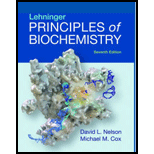
Concept explainers
(a)
To determine: The reaction quotient for the given reaction, for the PFK-1 reaction under physiological conditions.
Introduction:
Reaction quotient is the ratio of product of concentration of reaction products to the concentration of reactants at a particular time during the course of the reaction. It is calculated to determine the progress of the reaction.
(a)
Explanation of Solution
Explanation:
The concentration of fructose-
The concentration of fructose-
The concentration of ATP is 11400 µM.
The concentration of ADP is 1320 µM.
The reaction quotient of the given reaction is calculated by the formula,
Where,
- [fructose-1,6-bisphosphate] is the concentration of fructose-1,6-bisphosphate.
- [fructose-6-bisphosphate] is the concentration of fructose-6-phosphate.
- [ADP] is the concentration of ADP.
- [ADP] is the concentration of ATP.
- Q is the reaction quotient.
Substitute the values of [fructose-1,6-bisphosphate], [fructose-6-bisphosphate], [ADP], and [ATP] in the above equation.
Conclusion:
The reaction quotient of the given reaction is
(b)
To determine: The equilibrium constant of the given reaction.
Introduction:
Equilibrium constant is the ratio of product of concentration of reaction products to the concentration of reactants at equilibrium stage of the reaction. The equilibrium constant is equal to the reaction quotient when the reaction is at equilibrium.
(b)
Explanation of Solution
Explanation:
The standard free energy change of the reaction is -14.2 kJ/mol.
The standard free energy change of the given process is calculated by the formula,
Where,
- ΔG°is the standard free energy change of the reaction.
- R is the gas constant.
- T is the temperature of the reaction.
- K is the equilibrium constant of the reaction.
The equilibrium constant =
Substitute the values of R, T and K in Equation (1)
Conclusion:
The equilibrium constant of the given reaction is 308. .
(c)
To determine: The comparison of reaction quotient and equilibrium constant of the given reaction.
Introduction:
Equilibrium constant is the ratio of product of concentration of reaction products to the concentration of reactants at equilibrium stage of the reaction. The equilibrium constant is equal to the reaction quotient when the reaction is at equilibrium.
(c)
Explanation of Solution
Explanation:
The progress of the given reaction is determined by comparing the values of reaction quotient and equilibrium constant for the given reaction. If the reaction quotient is less than the equilibrium constant, then the reaction moves in the backward direction. This means that the concentration of reactants is more than that of the products in the given reaction. If the value of reaction quotient is more than the equilibrium constant, then the reaction moves in the forward direction and the concentration of products is higher than that of the reactants. The reaction is at equilibrium when the reaction quotient is equivalent to the equilibrium constant.
The reaction quotient for the given reaction is much less than the equilibrium constant. Therefore, the given reaction is far away from the equilibrium. Therefore, the concentration of reactants which is fructose-6-phosphate and ATP is higher and the reaction is in the backward direction.
To determine: The role of PFK-1 as a regulatory enzyme.
Introduction:
Enzymes are commonly known as the biological catalyst which initiates and speeds up various reactions occurring in the human body. The activity of the given enzyme as catalyst is determined by the
Explanation of Solution
Explanation:
PKF-1 which is phosphofructokinase-1 is the most important regulatory enzyme which acts as a catalyst for the steps involved in the glycolysis. It speeds up the reaction of fructose-
The activity of the given enzyme is very less for the given reaction because the reaction occurring in the cells would not attain equilibrium easily. Therefore, the activity of the PKF-
Want to see more full solutions like this?
Chapter 15 Solutions
Lehninger Principles of Biochemistry
 BiochemistryBiochemistryISBN:9781319114671Author:Lubert Stryer, Jeremy M. Berg, John L. Tymoczko, Gregory J. Gatto Jr.Publisher:W. H. Freeman
BiochemistryBiochemistryISBN:9781319114671Author:Lubert Stryer, Jeremy M. Berg, John L. Tymoczko, Gregory J. Gatto Jr.Publisher:W. H. Freeman Lehninger Principles of BiochemistryBiochemistryISBN:9781464126116Author:David L. Nelson, Michael M. CoxPublisher:W. H. Freeman
Lehninger Principles of BiochemistryBiochemistryISBN:9781464126116Author:David L. Nelson, Michael M. CoxPublisher:W. H. Freeman Fundamentals of Biochemistry: Life at the Molecul...BiochemistryISBN:9781118918401Author:Donald Voet, Judith G. Voet, Charlotte W. PrattPublisher:WILEY
Fundamentals of Biochemistry: Life at the Molecul...BiochemistryISBN:9781118918401Author:Donald Voet, Judith G. Voet, Charlotte W. PrattPublisher:WILEY BiochemistryBiochemistryISBN:9781305961135Author:Mary K. Campbell, Shawn O. Farrell, Owen M. McDougalPublisher:Cengage Learning
BiochemistryBiochemistryISBN:9781305961135Author:Mary K. Campbell, Shawn O. Farrell, Owen M. McDougalPublisher:Cengage Learning BiochemistryBiochemistryISBN:9781305577206Author:Reginald H. Garrett, Charles M. GrishamPublisher:Cengage Learning
BiochemistryBiochemistryISBN:9781305577206Author:Reginald H. Garrett, Charles M. GrishamPublisher:Cengage Learning Fundamentals of General, Organic, and Biological ...BiochemistryISBN:9780134015187Author:John E. McMurry, David S. Ballantine, Carl A. Hoeger, Virginia E. PetersonPublisher:PEARSON
Fundamentals of General, Organic, and Biological ...BiochemistryISBN:9780134015187Author:John E. McMurry, David S. Ballantine, Carl A. Hoeger, Virginia E. PetersonPublisher:PEARSON





